Exit: A Biodelic Adventure review
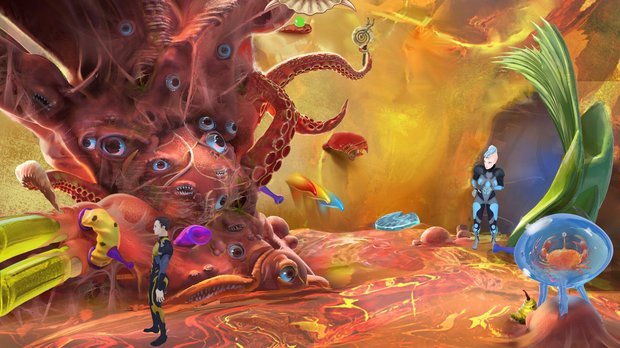
- 0 Comments
Uniquely, unrelentingly weird, this cyberpunk point-and-click adventure is sure to grow on you if you keep coming back
I bet you and I are a lot alike in how we play adventure games. For instance, while I’m sure you’re an old hand with the verbs involved in puzzle solving—your “Use,” your “Pick Up,” your “Talk to”—-I assume it’s never occurred to you to stop and ask the buttons how they feel about it. Then again, maybe it has; maybe everybody out there has been thanking “Push” and “Pull” for their help all these years, and I’m the inconsiderate one. I don’t know. All I can say for sure is that after playing Exit: A Biodelic Adventure, the weird and often wonderful debut title by Neurosaur Games, I’ve been doing a lot of soul-searching about the interfaces in my life and how I can support them better. After all, we’re in this together.
Like its mostly mute protagonist, whose sentient, implanted organs work in concert to assist and guide him, Exit is more than the sum of its parts. At first blush it seems like a fairly traditional third-person point-and-click, with a familiar verb-icon control scheme and a selection of inventory puzzles to power through. Spend a little time with it, though, and you’ll find yourself bouncing off the walls of a psychotropic, no-holds-barred adventure dreamscape like little else the genre has seen. Its overwhelming strangeness takes some getting used to, but Exit’s two-fisted, gleefully gonzo approach to just about everything is so infectious that it’s hard not to kick back and laugh with it. It sometimes buckles under the weight of all that madcap energy, but by its very nature such shortcomings feel forgivable: after all, in a world where your ear can abruptly sprout legs and strike out on its own, why wouldn’t the puzzles be a bit bizarre?
Exit depicts a distant future in which humankind has remade both itself and the world using advanced forms of biotech and genetic engineering. Everything from infrastructure to architecture to home appliances is organic in nature: complex systems are run by creatures bred specifically to manage them; doors open and computers activate only if your DNA contains the proper key; a vast and incredibly literal neural network connects everybody at all times. People have the freedom to reshape, reorganize and redefine their bodies as they see fit, with the only limits those of imagination and software compatibility.
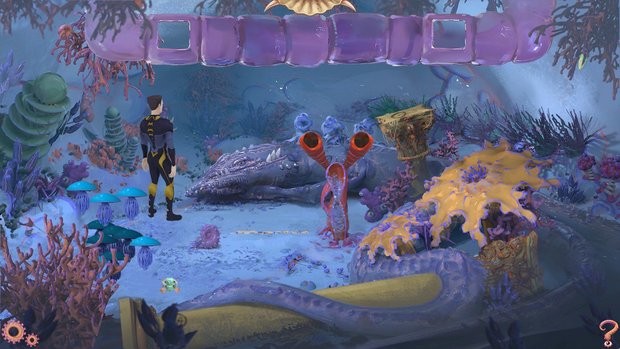
As technology progressed, however, people became more and more dependent on it, first allowing the technorganic system to automate their daily lives, then to alter their perceptions, and finally to manage and adjust their emotions. Their growing reliance on the integrated network left them vulnerable to the coming of the Worm: a mutation within the system that led it to seize full control of its hosts, leaving them its unwitting prisoners who see, think, and do only what it allows. Just when it seemed like things couldn’t get worse, they did: a mysterious alien presence has been detected in the atmosphere, with no indication of its intentions.
It’s at this point that we meet Adem, the player character, a young man with a fractured psyche who emerges gasping from a stasis chamber with no memory of how he got there…except that Bina, the woman he loves, was somehow responsible. Why did she lock him in stasis? Why does she immediately flee without explaining things once she sees he’s awake? Is she infected with the Worm, or is something else at play here? Luckily for Adem, he’s not alone. Like most people in this world, his body sports a full complement of thinking, speaking bio-implants, and they’re committed to picking up the slack for their host as he tries to figure everything out. With the help of his fleshy friends, Adem sets out to locate Bina, regain his memory, and chart a course through the Worm-induced pandemonium.
The controls will be familiar to anyone who’s played a Sierra game, albeit with a few tweaks. Adem’s implants function like a mix between inventory items and traditional verbs, stored on the left-hand side of a dropdown menu; objects you pick up appear on the right. Clicking an implant or item swaps it in for the cursor, at which point you can take it out and use it in the environment. The icon for the menu sits in the lower left corner of the screen, while the hint icon is in the lower right. (More on that later.)
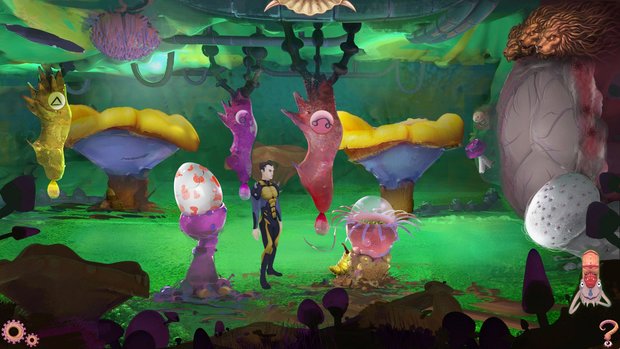
Most important of your implants is your Reference Mollusc, a slug-like encyclopedia who behaves something like an advanced “Look at” icon. It not only describes what you’re seeing, but provides context for its purpose and place in the world. Clicking the Mollusc on a zhirble, for instance, won’t simply tell you what it is, but will also remind you never to drink it without a chorble present. (Though, of course, that should go without saying.) Also along for the ride are Adem’s mouth, nose, and ear implants, as well as the bioport that lets him interface with various devices. Rounding out the gang is Slimey, Adem’s somewhat manic Virtual Assistant program. He floats around the screen and periodically shares his observations with the others. (I have no idea why Slimey is a “he” except that they all refer to him that way—to my mind he just looks like an over-caffeinated nautilus.) While you don’t control or interact with Slimey directly, you’d (probably) miss him if he wasn’t there.
The implants, and the way they converse and play off of each other, are the heart and soul of the game. Though you control Adem by clicking in the environment as you would any other third-person adventure protagonist, the process feels less like manipulating an avatar through the gameworld than it does being part of a team trying to manage a common goal. Each has its own personality and point of view, which it will happily share at the first opportunity; considering you have five separate implants available to weigh in on any given hotspot, there are an impressive number of specific, individual responses, with few generic “I can’t do that” equivalents in the mix. Adem’s time in stasis seems to have cost him his voice, so it’s up to his implants to speak for him. Whichever one you happen to use, it will report its findings back in its own distinct way. (Why the mouth can speak when Adem can’t is a “just go with it” sort of question.)
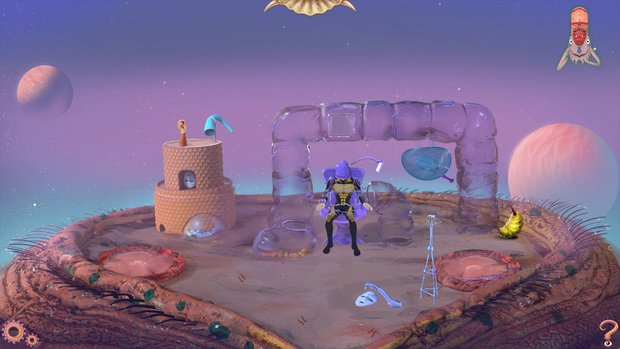
The Reference Mollusc, first among equals, is cool-headed and logical. The lonely bioport dreams of one day finding and connecting with a compatible umbilicus. There’s also the forthright mouth; the observant, independent ear; and the nose, who’s always down to try new things. Other, temporary implants join your roster in unique situations, like a leech-symbiote that lets you control a helpful pufferfish, but once their jobs are done you lose them again. There’s also Adem’s hand, for when you need to use or pick something up, but as it lacks modifications it has about as much to say as yours would.
Using any one implant on a hotspot often causes several of them to chime in, offering alternate suggestions or tossing good-natured barbs at their companion. On top of this, the biotech scattered everywhere means that fixtures, appliances, and animals are often sentient and vocal, so when an implant observes something in the environment, the environment often observes it right back. Simple interactions frequently lead to elaborate conversations and amusing character moments that keep the team feeling lively and your surroundings full of surprises.
The scores of twitching, wriggling details on each screen ensure you’ll never forget how wonderfully, frighteningly alive this world is. Walls are covered in fleshy protrusions; disembodied mouths, eyes, and appendages gasp, blink, and undulate in odd places. Doors and windows frequently resemble body parts, while any number of horns, teeth, and organs take the place of levers, buttons, and consoles. You’ll come across machines powered by the movement of beetles, worms and cephalopods; learn to control a clean-up drone with the power of smell; and dodge the amorous tentacles of a lovestruck pump system. Everything is depicted in a rainbow of neon shades, and the 3D character models blend remarkably well with 2D backgrounds that feature both hand-painted and pre-rendered elements.
With such busy, unusual visual environments, it’s sometimes hard to know what to do or even look at next. Thankfully a button press highlights all hotspots, which further de-clutter the screen by deactivating once they’ve served their purpose. Still, there’s a lot going on wherever you look, and it’s easy to freeze up in a new room as you figure out where the hell to even start. This, along with a barrage of made-up biotech terms (see zhirble and chorble, above), can complicate puzzles that might otherwise feel more straightforward. It’s a challenge to know how to use two objects together when you’re still figuring out what they are.
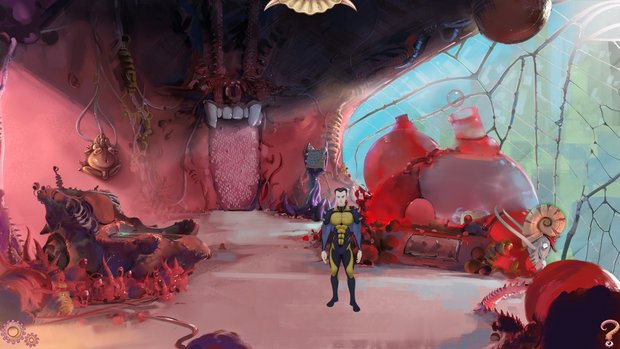
The most egregious example comes during a sequence featuring several organic compounds you’ll need to escape a particular room. Literal-sounding names like “atrophyrium” and “gluetor” mean you can eventually intuit what these substances do, but as some names seem to mean similar things, it takes longer than it should. How, save by trial and error, would one know whether a situation calls for “removite” rather than “dissolvia,” for instance? On top of that, each dispenser produces multiple compounds, requiring you to toggle between them, and they all play a part in a puzzle sequence with numerous other steps. By the time you get it all worked out and each step straight in your head, you’ll be desperate to move on.
That said, and with full acknowledgement that the process of working out how everything functions can feel like a chore, there’s a kind of mad joy in successfully decoding the game’s warped but indisputable logic to solve a puzzle. The rules governing Exit’s world may be bizarre, but there are rules, and you can make progress if you pay attention and learn to operate within its skewed reality. Failing that, there’s a helpful hint system that first reminds you of your immediate goal and then, if that’s not enough, tells you what your next step should be. (For those who doubt their self-control around hint usage, there’s “Hardcore Mode” that shuts the hint system off for a time after each use.)
While many puzzles are inventory-based, the ever-present organic tech allows for some unexpected obstacles that require creative and complex thinking to overcome. Early on you’ll get a device that lets you extract genetic material (“genma”) from living creatures to be loaded onto an organic USB drive (“bioflash”), which you can then use to modify anything with a compatible bioport. Another memorable sequence sees Adem strapped into a machine that disengages his implants and lets them move about under their own power, granting you direct control of the lot while switching back and forth between them à la the Gobliiins games. Without an inventory, you’ll have to position each implant such that its talents can serve your needs. Yet another set piece features a mechanism for transferring one implant at a time into a creature under your control before navigating it to places Adem can’t go.
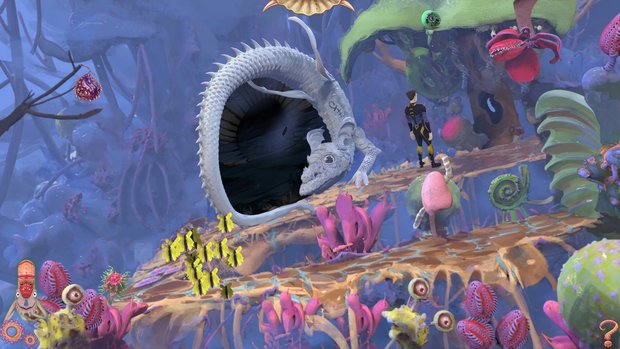
The only real dud of the bunch is a logic puzzle in which you enter Adem’s psyche and essentially talk him through a hallucinatory panic attack via dialogue options. (Owing to Adem’s silence, the only interactive conversations take place in his head.) Nothing I saw distinguished the right choices from the wrong ones, and a single incorrect response would start the whole multi-step process over again. It’s not the game’s only “choose wisely” sequence—there’s more than one puzzle whose solution seems to hinge on just guessing and hoping you’re right—but a misstep in the others results in being nudged gently toward the right answer while retaining your progress. Here there’s no such mechanism, which leaves it feeling like an extended exercise in random, clueless chance.
While Exit’s bonkers energy and elaborate, multi-stage puzzles undoubtedly take center stage, there’s still a substantial and serious narrative at its heart. Naturally, in a setting centered on self-modification and the blurring of lines between humanity and its creations, there’s some meaty exploration of the nature of identity, the value of imperfection, and the opposing human urges for comfort and change. Adem proves a more compelling character than he seems at first, defying the apparent blankness of his slate; the more we learn about him in the five-plus hours we spend with those who know him best, the more we come to understand not only who he is but how and why he got that way.
Unfortunately, there’s one element of the game’s finale that fell utterly flat for me. While the script mostly strikes a good balance between whimsy and pathos in its heavier moments, an extended jokey meta-revelation at the very end is neither interesting nor particularly funny. For the most part it doesn’t affect the rest of the game, but it resolves what had previously seemed like a compelling story thread with a couple of tossed-off, expository punchlines. The subplot in question ultimately comes to so little that the game might have been better served excluding it entirely.
There are a few other places where Exit’s seams can’t help but show as well. Occasional translation errors blunt some lines’ impact, and while the lack of voice acting wasn’t a problem for me—the implants are so full of charm and personality that I barely missed it—it’s hard not to wonder how these developers might have utilized a full soundscape. As it is, the buzzing, electro-synth soundtrack sets the tone well, balancing ominous minor-key droning with more relaxed, funky tracks to create a mood of mingled apprehension and grooved-out wonder. That said, the various pieces are short and repetitive, and they risk overstaying their welcome if you spend too long in one place.
Final Verdict
Exit: A Biodelic Adventure overcomes its flaws by simply refusing to apologize for being itself. From toe to tip, this is a deeply and utterly weird game, and that risks turning off a good number of players; despite its many excellent qualities, I’ve rarely deployed the phrase “not for everyone” more emphatically. However, for the developers to pull back on any one of its aesthetic throttles—visual, conceptual, material, you name it—would risk sacrificing much of what makes Exit special. No matter how you feel about it, there’s simply no mistaking even the smallest part of it for any other game; verb icons may come and go, but my chattering, bickering bio-implants will stay with me forever. (Unless, of course, they decide to grow legs and leave.)
Hot take
The unapologetically strange Exit: A Biodelic Adventure drops you into a hallucinatory dystopia and challenges you to find your way through. It’s a heartfelt and often hilarious journey through a living, breathing world that may overwhelm the senses but certainly never bores.
Pros
- Interface that uses bio-implant “verbs” with personality is a delight from start to finish
- Beautifully bizarre biotechnological world is fascinating to explore
- Many creative puzzle types that make full use of the setting’s wild potential
- Unique in just about every way
Cons
- So much going on that it’s sometimes hard to get your bearings
- Some puzzles don’t work as well as the others
- Occasional translation errors and awkward tonal shifts
Will played Exit: A Biodelic Adventure on PC using a review code provided by the game's publisher.





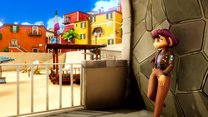





0 Comments
Want to join the discussion? Leave a comment as guest, sign in or register.
Leave a comment